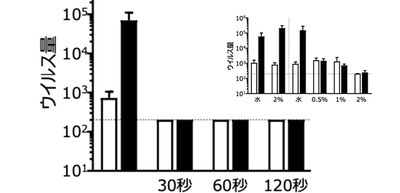
A wide range of applications: Alcohol-based disinfectants inactivate human norovirus
A group of researchers from the Research Institute for Microbial Diseases of Osaka University demonstrated that human norovirus (HuNoV) inactivation was achieved by adjusting the pH of alcohol-based disinfectants in experiments using human iPSC-derived intestinal epithelia cells.
Enveloped viruses, such as influenza viruses and coronaviruses, are susceptible to alcohol-based disinfectants, but non-enveloped viruses such as HuNoVs are not inactivated by benzalkonium chloride and rubbing alcohol.
The virucidal effect of alcohol is enhanced by increasing its pH value. However, the effect of commercial acidic alcohol with low pH, some of which are sold in Japan under the trade name associated with the virucidal effect on HuNoVs, was unknown.
In this study, the group showed that a solution containing about 2 million HuNoV particles was completely inactivated and that the virus infectivity and propagation were abolished by three-fold or nine-fold volumes of acidic or alkaline solution within 30 seconds of incubation.
HuNoVs are found in the stool or vomit of infected people and these organic substances abolish the virucidal activity of decontamination agents. By adding an inorganic salt chemical compound magnesium sulfate (MgSO4), which causes protein aggregation (salting-out), to acidic alcohol by 0.1%, HuNoVs containing 5% beef extract were inactivated.
This group thinks that since proteins adhering to virus surfaces were removed due to the salting out effect of MgSO4, alcohol molecules were able to act on virus particles. Some commercially available alcohol-based disinfectants in Japan have no virucidal effects on non-enveloped viruses. The reason for this, they think, is that ingredients, such as moisturizers and swelling agents used in these products, abolish the virucidal activity of acid–ethanol against HuNoVs.
This group demonstrated that, alcohol-based disinfectants, except neutral ones, have inactivation effects against HuNoVs, which are comparable to the effects of sodium hypochlorite [NaClO]. Acidic and alkaline alcohol can be created using food additives such as citric acid and used as hand sterilizers as with conventional alcohol-based disinfectants. These disinfectants can also be used as a substitute of NaClO, which may irritate the skin or cause burning pain, inflammation and blisters.
Since citric acid (lemon juice can be used as a substitute for citric acid) or baking soda can be used to adjust pH and generate acid-alcohol disinfectants, this group’s research results will be helpful in developing and verifying hand sterilizers for HuNoVs. This group’s achievements will lead to the establishment of criteria for virus inactivation using HuNoVs as a benchmark, and quality verification of disinfectants and decontamination agents.
Figure 1
The article, “Alcohol abrogates human norovirus infectivity in a pH-dependent manner,” was published in European Journal of Heart Failure at DOI: https://www.nature.com/articles/s41598-020-72609-z.
Related links
Sato Group, Research Institute for Microbial Diseases, Osaka University (link in Japanese)
